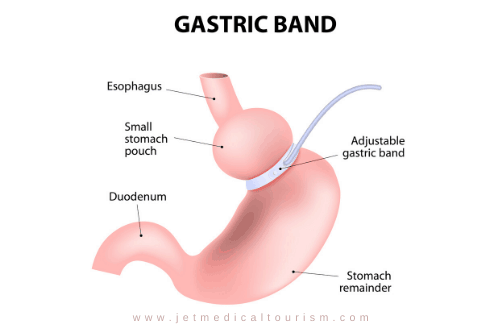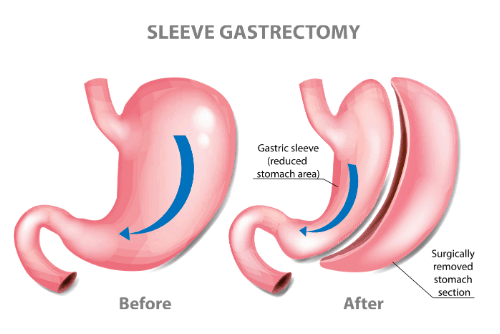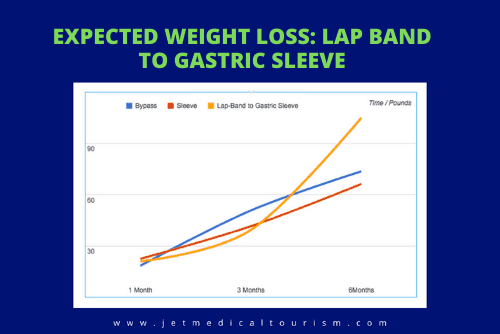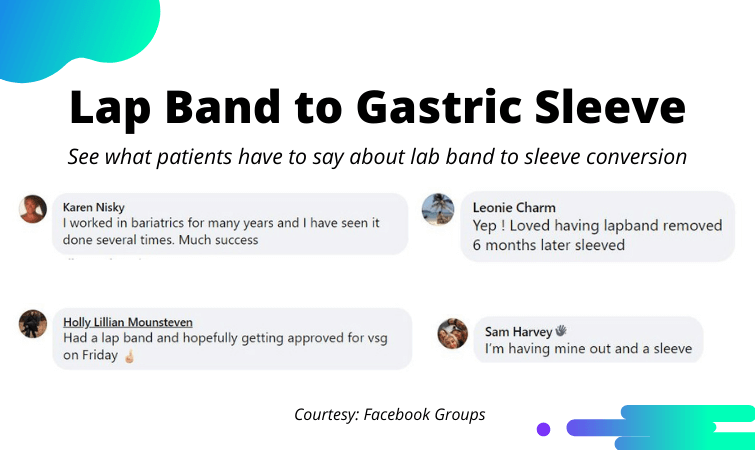Should You Consider Lap Band to Gastric Sleeve Conversion Surgery?

Obesity is now being recognized as a severe physical and mental issue that’s continuing to plague so many Americans despite various efforts made by the government and public health organizations to increase awareness.
According to the, CDC, nearly two in five Americans suffer from obesity, which has also given rise to obesity-related diseases like type-2 diabetes and heart ailments.
As you go through the motions of life, it’s not always easy to keep a strict eye on what you are eating and whether or not your body is getting enough exercise. In some cases, even one weight-loss surgery may not be enough to manage your weight.
If your first gastric lap band surgery failed to result in a significant weight loss, or if the Lap Band led to some health complications, it may be time to consider a lap band to gastric sleeve conversion.
Up until a few years ago, gastric lap band surgery was the most popular type of weight loss procedure. A lap band is an adjustable band made of silicone, and it goes around the top-portion of your stomach to restrict the amount of food you can consume.
In some rare cases, the lap band patients find themselves experiencing frequent digestive issues like vomiting or acid reflux. This usually happens because the lap band either loosens or slips out of place over time. It’s also possible that you may have regained the lost weight after 5-10 years following lap band surgery.
Regardless of the reason, if you are considering a lap band to gastric sleeve conversion, this post will help you learn all about either procedure. Contact Jet Medical Tourism® today.
Failed lap band
Lap band failure is one of the major reasons why many bariatric surgeons today do not recommend adjustable gastric band surgery. A failed lap band will defeat the purpose of your surgery and you may not achieve your weight loss goals. Lap band revision to gastric sleeve is one of the effective solutions after the failure of the primary surgery. Here are the common problems that can result in a failed lap band:
- Band Erosion: Lap Band erosion or band migration may occur in up to 10 percent of patients. In this condition, the band will start growing or penetrating into the stomach, causing complications. Band removal and lap band to gastric sleeve revision are the two corrective options after erosion.
- Band Infection: Some patients may develop lap band infection either quickly after the surgery, or at a later stage. Your weight loss surgeon will first try to treat the infection with antibiotics. However, if the infection is more severe, lap band removal, and gastric sleeve may be the only choices.
- Band Slippage: Up to one in five patients may develop the problem of lap band slippage. This can happen when the lower portion of the pouch slips through the lap band. This causes the stomach to become large once again. Surgical repositioning of the band or band to sleeve conversion may be considered.
- Band Intolerance: In a few cases, the patient may develop lap band intolerance after the surgery. Symptoms may include vomiting, nausea, and persistent stomach discomfort. If the symptoms do not resolve with oral medications, you may consider gastric sleeve after lap band removal.
Removal of lap band
If you develop complications after your lap band surgery, removal of gastric band may become necessary. Lap band removal is usually performed laparoscopically to make the surgery less invasive. Here are the surgical steps involved the removal of lap band:
- Step 1: You will be placed under general anesthesia or local anesthesia with IV sedation, depending on the surgeon’s decision.
- Step 2: Your surgeon will create very small incisions in the stomach area. They may try to use to the original incision lines to minimize scarrings.
- Step 3: Through the incision, the surgeon will insert a laparoscope into the stomach so that they can view the damaged lap band on an external screen.
- Step 4: The surgeon will precisely cut out the scar tissue enveloping the lap band. Thereafter, they will cut the band and tubing, and pull out the band.
- Step 5: The old sutures in the stomach will now be removed to restore your original stomach anatomy. This will make the revision surgery easier later on.
- Step 6: Your surgeon may perform lap band removal and sleeve at the same time, or the revision may be performed later. This will depend on your surgical plan.
- Step 7: The surgeon will remove the subcutaneous port and the external incisions will be closed with fine sutures. This will complete your removal of gastric band procedure
Lap band vs. gastric sleeve: pros and cons
If you’ve gone through a lap band surgery, and the band is not working anymore or you are suffering from some side-effects, a revision surgery might be the best option for you. A conversion to gastric sleeve will help fix the issues caused by the lap band, and also help you shed the weight much faster.
RELATED ARTICLE: All you need to know about revision weight loss surgery
A gastric sleeve is a minimally-invasive procedure, compared to other bariatric surgeries. And the best part is, it doesn’t require the same upkeep as the lap band either; you won’t need to visit the surgeon every few months to get your band adjusted if you sign up for a gastric sleeve.

Lap Band: During this surgery, the bariatric surgeon ties off most of your stomach, leaving only a very tiny portion. As a result, when or if you overeat, you’ll feel so uncomfortable and sick that you will hopefully do your best to avoid it.
So, your brain should create a negative association with excessive eating, helping you to eat smaller portions throughout the week and year.
Pros of Lap Band:
- A lap band surgery is reversible.
- It can be adjusted over time to suit your changing lifestyle.
Cons of Lap Band:
- Weight loss with a lap band takes more time, compared to gastric sleeve.
- You’ll need to undergo additional procedures for band adjustments.
CHECK THIS OUT: Gastric sleeve vs gastric lap band
The rate of risks and complications is higher than other bariatric surgeries; the band may leak or slip, leading to serious medical issues.
READ ALSO: What is lap band removal surgery?

Gastric Sleeve: Also known as vertical sleeve gastrectomy, it reduces the size of your stomach by 70-85%. Unlike the lap band surgery, gastric sleeve doesn’t change the function of your digestive tract.
But the main reason why gastric sleeve is one of the most effective bariatric procedures today is because it reduces the production of hunger-causing hormone ghrelin significantly. Since you will stop feeling hungry as much as you normally do, you will stop overeating which includes consuming unhealthy snacks as well.
YOU MIGHT LIKE: Is a gastric sleeve worth it?
Pros of Gastric Sleeve:
- It is the most effective bariatric procedure for majority of obese and morbidly obese patients who are at higher risk for complications during the surgery.
- It causes you to lose weight faster than any other bariatric solution.
- It is minimally invasive and is generally performed laparoscopically.
- It drastically reduces your appetite and discourages overeating.
- It only changes the size of your stomach – not the way how your digestive system works.
Cons of Gastric Sleeve:
- A gastric sleeve surgery is irreversible.
- If you still continue to overeat after the surgery, you may experience the ‘dumping syndrome’, which can be a serious condition.
RELATED ARTICLE: Pros and cons of gastric sleeve surgery
Which is better: A lap band or gastric sleeve?
Considering all the pros and cons of both surgeries, it is clear to see why most patients prefer the gastric sleeve.
- For starters, with the rising healthcare costs, not everyone can afford to go to the doctor to get their lap band adjusted every couple of months. You have to get the lap band adjustment regularly otherwise it will result in vomiting, acid reflux, and other problems.
- And with every adjustment surgery, you’ll have to spend some time recuperating at home as well.
- If you’re like most people, who has a job, family, and other responsibilities, choosing a lap band may not be the most prudent choice.
This is why we recommend a gastric sleeve or lap band to gastric sleeve conversion and not the lap band; it’s much more suitable for the modern, busy individual. Still wondering which is better, lap band or gastric sleeve? Our bariatric specialists at Jet Medical Tourism® will be more than happy to give you a thorough medical evaluation for a more precise picture.
Obtaining a gastric sleeve after a lap band failure
We always do our best to communicate the risks, whenever a patient requests a gastric lap band surgery. Of course, not every patient will experience problems, but when they do, they should be able to recognize the signs.
A lap band failure can simply mean that the patient did not lose any weight after the surgery, or they didn’t lose enough weight.
But sometimes, it can also mean that they start experiencing the side-effects of the lap band after their operation. The most common symptoms of this are indigestion, vomiting, and acid reflux. But in some severe cases of lap band failure, the patient can go through the following issues:
- Leakage from the band
- Band slippage
- Problems with bowel movement
- Blood clots
- Hiatal hernia
- Esophageal dilation
- Perforated bowel
If you don’t follow the diet changes recommended by the doctor after your lap band surgery, it will result in a number of complications. If you overeat, it will cause food to travel back to your esophagus, leading to nausea and vomiting. Not pleasant!
Or, if you don’t go in for regular fills to keep your band functioning properly, this will also result in some of the medical issues listed above that lead to lap band failure.
Whatever might have been the reason for the failure of your band, you can undo the complications and resume your weight-loss journey by choosing a gastric sleeve procedure. A sleeve gastrectomy comes with fewer side-effects and risks compared to the gastric lap band.
Also, as mentioned earlier, gastric sleeve is not as invasive as other bariatric surgeries; there is no cutting required. The doctor will only need to remove the band and place a set of stitches on the top part of the stomach.
CHECK THIS OUT: How does gastric sleeve work
This will result in a smaller stomach and thus, reduced appetite. You’ll naturally feel fuller faster when you eat after your lap band to gastric sleeve surgery.
Gastric sleeve after lap band removal
Lap band revision to gastric sleeve is the most widely chosen option in case of a failed lap band. If you simply choose removal of lap band without a revision surgery, your stomach will return to its original size. You may regain weight in this condition and your obesity-related medical symptoms may also reappear. Therefore, experienced bariatric surgeons usually recommend gastric sleeve after lap band removal.
When to Undergo Revision Surgery
During your pre-op consultation, your surgeon will explain to you the pros and cons of lap band vs. gastric sleeve. If you are ready for lap band to gastric sleeve revision, the surgeon will discuss the timing of the revision surgery. In some cases, lap band removal and sleeve at the same time may be a better option. However, some surgeons may prefer to perform gastric sleeve after lap band removal with a gap of about three months.
Revision Procedure is Irreversible
It is important to understand that while adjustable gastric band surgery can be reversed with removal of the band, the band to sleeve conversion is irreversible. In the lap band gastric sleeve revision, the surgeon will remove about 80% of your original stomach volume. This condition cannot be reversed later, so you should be fully committed to following the surgeon’s dietary guidelines for best results after your revision procedure.
YOU MIGHT ALSO LIKE: Lap band removal after 10 years: Everything you need to know
Lap band to gastric sleeve conversion process
To change a lap band to a gastric sleeve, the surgeon will remove the band first and then proceed with the gastric sleeve surgery. All of this is performed laparoscopically, i.e., via a tiny camera that’s inserted inside to give a clear view to the surgeon.
During the sleeve gastrectomy, about 80% of your stomach will be removed. The rest of it will be stapled off to form the size and shape of a banana or a ‘sleeve’.
Due to the substantially diminished capacity of your stomach, you’ll lose weight faster than you can imagine. Most patients lose 40-50% of the extra weight within 3-4 months after undergoing a gastric sleeve surgery. Also, the amount of hunger-causing hormone, ghrelin, will be reduced so much that you won’t feel the hunger as frequently and as intensely as you did before. In other words, say goodbye to your cravings!
Lap band revision to gastric sleeve cost
In the US, the average cost of lap band to gastric sleeve conversion is about $15,000 to $30,000, depending on how severe your lap band failure complications are. Make sure you talk to your insurance company to see if they will pay for the lap band removal and/or gastric sleeve surgery.
The majority of insurers don’t cover any type of weight loss surgery. Some health insurance companies only cover one bariatric procedure, so while they may pay for your lap band, it’s highly unlikely that they will cover its removal as well.
This is why most patients prefer to cross the border to receive bariatric medical care.
In Mexico, a lap band to gastric sleeve revision surgery only costs about $4,000 to $5,000, helping patients save thousands of dollars.
Lap band revision to sleeve insurance
Lap band revision to gastric sleeve cost in the US or Canada is substantially high. When you are considering this surgery, you should call your insurer to check whether they will provide lap band revision to sleeve insurance coverage. If the insurance company had covered your primary bariatric surgery, chances are that they may also offer you coverage for the revision procedure.
Conditions for Coverage
The insurer will determine whether you are seeking lap band removal and gastric sleeve because of medical complications or for cosmetic reasons. If your concern is only insufficient weight loss with gastric band, it may not qualify you for coverage for the revision surgery. However, talk to your insurance provider for your best options.
Waiting Period
In general, weight loss surgery involves a fairly long waiting period if you want to get the benefit of insurance. This could pose a hurdle for your lap band revision to sleeve insurance coverage, especially if you need to get this surgery done quickly for medical reasons or to meet your personal weight loss goals.
Deductibles and Co-Pays
Even when you qualify for your insurance coverage for your gastric sleeve after lap band removal, you should carefully evaluate your deductible amount and co-pay amount. These and other out of pocket costs, such as consultation, medical tests, and prescription drugs may turn out to be significantly high.
Is signing up for a lap band removal and sleeve at the same time smart: Yes or No?
Absolutely yes! Our weight loss surgeons do this all the time. Your lap band can be removed and converted to a gastric sleeve or any other bariatric solution of your choice. We try to do both lap band removal and sleeve at the same time to save the patient from additional expenses for hospitalization, anesthesia, etc. It’s a sagacious decision.
However, it’s crucial to note that there are always exceptions. If your lap band has done some extensive damage to your stomach, it might be better to enable your stomach to heal first. It’s better to consult with an expert bariatric surgeon to explore your options.
Lap band to gastric sleeve post op diet
Lap band to gastric sleeve success will largely depend on two factors: (a) Your weight loss surgeon’s skills and experience; and (b) Your commitment to follow your surgeon’s dietary guidelines. Lap band to gastric sleeve post op diet will be a key factor in the achievement and maintenance of your weight loss goals. The post op diet plan is more rigorous in the first two months, but thereafter it only requires self-discipline to maintain a healthy diet.
Stages in your lap band to gastric sleeve post op diet
- Stage 1: Clear liquid diet for the first week after your surgery
- Stage 2: Heavier or thicker liquid diet for the second week after surgery
- Stage 3: Soft and pureed foods from the third to sixth week after surgery
- Stage 4: Semi-solid diet from the sixth to eight week after your surgery
- Stage 5: Solid food (with some exceptions) from the third month after surgery
Tips for your lap band to gastric sleeve post op diet
- Focus on nutrient-dense foods in your diet.
- Avoid too much processed foods, sugary drinks, and fatty items.
- Increase the intake of lean proteins in your diet.
- Eat small portions and chew your food slowly and thoroughly.
- Do not let food become a source of comfort, and follow the plan.
- When visiting a restaurant, order half the regular portion size.
- Stay sufficiently hydrated, and drink at least 64 oz of water a day.
- Do not miss your daily nutrition supplements.
Recovery after Lap band to gastric sleeve
Lap band revision to gastric sleeve is a major procedure, which will involve a considerable recovery process. Schedule your surgery at a time when you do not have any other stressful engagements and you can commit yourself to a proper rest and recovery. During your initial consultation, your bariatric surgeon will guide you the various aspects of recovery after lap band to gastric sleeve.
- Incision Healing: You will experience mild soreness and swelling in the incision sites during the first week. This can be comfortably managed with pain medications that your surgeon will prescribe. Take plenty of rest in the first week to allow for safe incision healing.
- Return to Work: You should be able to resume your normal routine or go back to your workplace from the second week after your lap band to gastric sleeve surgery. However, request your employer to let you have only a desk job for a few days or perform remote working from home.
- Exercise Routine: Light activities, short walks and physical movement are important in the first two weeks. From the third week, you may start with gentle fitness exercises in consultation with your surgeon. But continue to avoid strenuous exercises for at least five to six weeks.
- Emotional Recovery: It is okay to feel vulnerable, lonely or irritable in the first few days after your lap band revision to gastric sleeve surgery. Enlist the support of your family members and friends in order to ensure a healthy and rapid emotional recovery.
Lap band to gastric sleeve success

The long-term success rate of lap band to gastric sleeve success is excellent. Our patients at Jet Medical Tourism are provided state-of-the-art medical care and expertise, which guarantees a healthy recovery. Where you choose to have this procedure is a paramount decision.
If the medical team is first-rate and the surgeons are award-winning pioneers in their industry, like what we have on board, it leaves very little room for failure.
Have more questions about lap band to gastric sleeve conversion? Feel free to call us at 1-855-506-6188 or leave us a message here.
Lap band to sleeve revision testimonials

Following a failed lap band procedure, it is natural to feel distressed or disappointed because your weight loss journey is disrupted. In this situation, you might feel skeptical or concerned about whether it is worth considering a revision surgery. To overcome your worries and to make a confident decision, you should review lap band to sleeve revision testimonials of past patients.
Patient testimonials will provide you valuable insights into how the revision surgery has benefited other patients. It will also provide you an opportunity to look at gastric sleeve vs. lap band pros and cons from the perspective of a patient rather than a surgeon. At your initial consultation, be prepared to request your surgeon for lap band to sleeve revision testimonials or reviews of actual patients.






